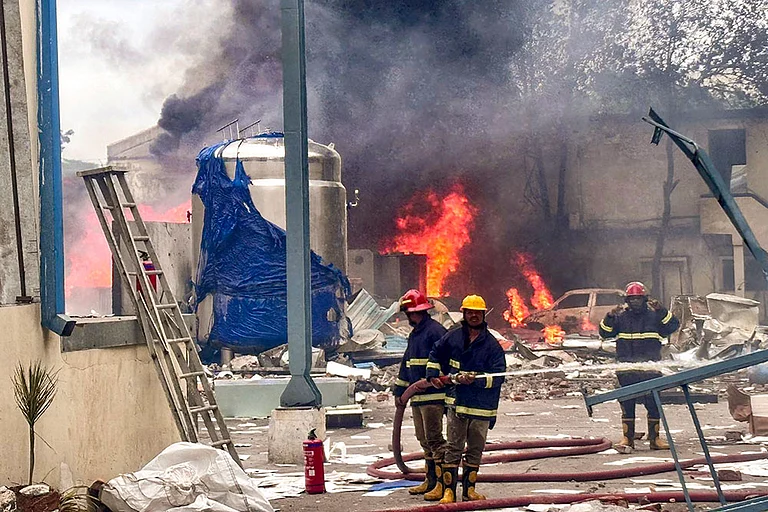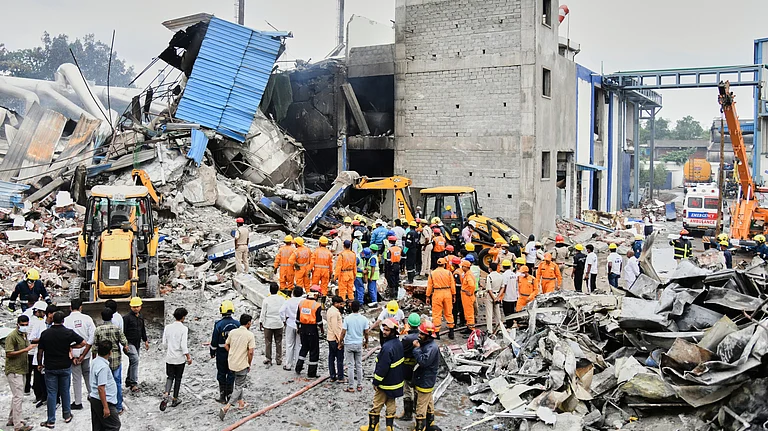A thick cloud of smoke and dust continues to linger over the remnants of the Sigachi chemical factory in Pashamylaram village, situated in the Sangareddy district of Telangana, even four days after a catastrophic explosion resulted in 38 fatalities and over 30 critical injuries.
The remnants of the facility, once dedicated to producing chemically inert microcrystalline cellulose (MCC), now consist of a chaotic assemblage of metal, debris, and ash.
Despite intermittent heavy rainfall, the atmosphere is permeated with the pungent odour of incinerated chemicals, resulting in sore throats and involuntary tears for those who venture near the site
Despite the ever-present danger, the rescue teams, including members from the National Disaster Response Force (NDRF), the Hyderabad Disaster Management and Asset Protection Agency (HDRAA), the Fire Force Department, law enforcement, and local authorities, have been working tirelessly for the past four days without a break

They are concentrated on identifying people who are still missing, days after the June 30 incident. These include nine victims as well as a plant manager. Amid the chaos, the factory premises are not just occupied by the rescue workers and security personnel, but also by the relatives of those missing. They stand united, imploring authorities to allow them to join the search activities.
A large number of people, particularly those who came to the village from Bihar, Uttar Pradesh and Madhya Pradesh in search of their deceased relatives, are converging at the government hospital in Pattancheru for DNA testing and to retrieve the remains of their loved ones.
A state government-operated camp is situated near the facility, offering assistance to catastrophe survivors, their families, and the relatives of the deceased.
“Dressed in protective equipment and masks, we continue to enter the factory’s ruins. Despite all measures, the toxic vapours remain intolerable. Our throats are inflamed, and our eyes are perpetually irritated,” says Sangareddy Superintendent of Police Paritosh Pankaj Mahesh, who momentarily halted before resuming the sombre duty of coordinating the rescue operations.
He has also observed that it was challenging to deter relatives who wished to participate in the rescue operations. Rescue teams are alternating shifts to rest at the location, capitalising on brief intervals of sleep before continuing their search in a time-sensitive endeavour.

Microcrystalline cellulose, a product of the company, possesses diverse applications in the pharmaceutical, food, and cosmetic sectors. It was arguably the largest producer of MCC.
The explosion is now regarded as the most catastrophic pharmaceutical tragedy the nation has ever encountered.
Employees of the collapsed factory claim that they were largely unaware of the safety hazards associated with the manufacturing process. They never foresaw such a calamitous disaster.
“The method is inherently dangerous; yet, the company assured us they were adhering to proper protocols. The fatal accident complicates our ability to continue working here,” stated a worker from Bihar who wished to remain anonymous.
Although it is one of the largest industrial parks in the nation, the Telangana State Industrial Infrastructure Corporation Park, which houses the facility, lacks immediate medical services.
The closest private healthcare centre is situated seven kilometres away, while the public hospital is nine kilometres away. So the rescue operations were delayed and performed in a way that fails to match with protocol.
“Rescue operations will require time. On the initial day, we dispatched nine heavy machines to remove the debris, all of which still remain operational. As we remove the debris, flames intermittently erupt, presumably triggered by chemical reactions, which we suppress with extinguishers,” said Mahesh.

Although persistent rainfall until July 1 night hindered rescue operations, work recommenced at dawn the following day unmindful of the changes in weather patterns.
On July 2, an additional body was retrieved from the rubble and taken to the government hospital for a postmortem investigation. Nevertheless, no other breakthroughs occurred. The body is unidentifiable due to the absence of relatives at the location to claim it.
Sigachi Industries, the proprietors of the factory, had a total workforce of 143 employees. As it claims, sixty employees who were found safe have been identified and brought to the rehabilitation camp. Thirty-five workers are injured and undergoing treatment, while the others are either deceased or missing.
The state government and the factory are offering prompt compensation to the relatives of the deceased and injured victims and the final settlement would be Rs 1 crore. Now, the government is providing medical and police services to convey the bodies to their designated residences.
Each relative of a recognised deceased individual would receive Rs 1 lakh as a contingency sum, while wounded parties will receive Rs 50,000 each as an interim disbursement from the government at present. Furthermore, the company is corresponding to this sum as part of their preliminary response. The full and final settlements would be held later.
Meanwhile, the latest incident has refocused attention on the pharmaceutical manufacturing sector, a crucial contributor to the nation's foreign exchange revenues. Such incidents, albeit often less serious, are not infrequent in this sector.
Less than a year ago, a comparable tragedy unfolded at a pharmaceutical company in Anakapalli in Visakhapatnam, leading to 17 deaths. In April this year, another incident occurred in Hyderabad, resulting in seven fatalities.
Professionals in the pharmaceutical and industrial safety domains assert that the principal cause of these occurrences may be equipment failures resulting from insufficient maintenance.
“The absence of maintenance may have caused an excessive accumulation of heat, ultimately resulting in the explosion,” observes Ravi Udaya Bhaskar of the All India Drugs Control Officers Confederation. He also says that this tragedy underscores the imperative of strict compliance with safety regulations and ongoing training.
Sigachi, producing 6,000 metric tonnes of MCC per year, asserts its position as one of the leading global suppliers of this substance. Meanwhile, R.K. Agarwal, head of the Bulk Drug Manufacturers Association, conjectured that the fire may have originated in the drying segment of the MCC production line.
A.V. Ranaganath, the commissioner of HYDRAA, stated that the temperature rise resulting in the thermal degradation of MCC ought to have elicited alerts. “The monitoring panels of the device did not register the temperature surge, and the alarm mechanism failed to activate. The temperature sensors are suspected to have malfunctioned,” he doubts.
Forensic and environmental agencies indicated that the proximate cause of the incident was the thermal decomposition of MCC, which ignites at temperatures exceeding 399°C. Investigators assert that this condition led to a dust explosion sufficiently powerful to damage sections of the factory and entrap people.
The Telangana Forensic Science Laboratory indicated that the substance’s warming likely precipitated the explosion; however, initial forensic collection was constrained by ongoing rescue operations.
At the time of the explosion, Sigachi Industries was functioning without a valid Fire No Objection Certificate (NOC), as verified by the District Fire Officer to the media.
The factory’s lapse in fire clearance signifies a significant breach of regulatory compliance, prompting enquiries about the continuation of operations without the requisite fire safety authorisation.
The absence of a valid NOC not only contravenes legal standards but also indicates deficiencies in routine fire inspections and enforcement protocols.
Sources from Telangana’s Department of Factories indicated that the interlocking mechanism, intended to immediately terminate heat or activate an alarm when temperatures beyond a safe limit, seemingly malfunctioned.
This defect lets temperatures escalate uncontrollably, leading to a perilous accumulation of heat and pressure. Officials underscored that regulating temperature is essential for both safety and product quality assurance.
A Telangana State Pollution Control Board (TSPCB) officer indicated that the explosion was likely instigated by an obstruction in the spray dryer, resulting in a perilous buildup of heat and pressure. The official stated that upkeep at the site was insufficient; without regular cleaning and servicing, spray dryers may pose significant risks.
Rajnala Sai Yashwant, whose father perished in the explosion, said that employees had consistently voiced apprehensions regarding the obsolete machinery at the factory. In his police complaint, Yashwant asserted that management had disregarded requests to replace obsolete equipment and continued to use it despite evident hazards.
The FIR asserts that the tragedy was a direct consequence of this negligence and has been filed under counts of culpable homicide not amounting to murder.
The timing of the explosion further exacerbated the elevated mortality rate. The incident transpired during the shift roll call, as both night and day shift employees congregated in the dryer area, the most hazardous section of the facility. Moreover, powder packing was in progress at that time, further exacerbating the congestion of the space
Investigators are examining potential faults in the sieves or filters that process the powdered version of MCC. These components are essential for ensuring consistency and averting dust accumulation, which could become explosive under specific conditions.
Authorities have expressed apprehensions regarding inadequate inspection and oversight. An official from TSPCB indicated that spray dryers are classified as pressure vessels, necessitating rigorous enforcement of safety measures by inspectors.
The official indicated that the incident was atypical, necessitating a comprehensive reassessment of the entire inspection system.
G. Ravi, the member-secretary of the PCB, affirmed that although the facility was authorised to function until 2027, the board will now issue a closure notice due to alleged violations.
Concerns regarding the negligent demeanour of plant management persist, as Telangana Labour Minister Vivek Venkataswamy attributed responsibility for the explosion to the management of Sigachi Industries. The Minister underscored that the pertinent authorities had promulgated safety rules that management had neglected to implement.
A representative from Sigachi Industries in Hyderabad clarified that the incident at their facility was not caused by a reactor explosion, but may have been triggered by a dust explosion in the drying area. “While we await the investigation results, we wish to clarify that the accident was not a result of a reactor explosion,” said the representative.
During an investigation at the accident location, Amit Raj Sinha, the Managing Director and CEO of Sigachi Industries, said: “The incident is not associated with a reactor explosion. We do not utilise any solvents in our facility. I suspect that a dust explosion transpired in the dryer portion; however, the investigation remains in progress.”
Sigachi Industries first reported 40 fatalities in the fire and explosion at their production facility, but then lowered the figure to 38. The company announced: “The verified count of fatalities is 38, as opposed to the previously reported 40 team members.” However, they did not delineate the number of deceased individuals who were full-time employees and contract workers.
The Chief Secretary of the State Government is presently leading an investigation into the incident.
In a statement issued on July 4, the company announced its intention to conduct a thorough investigation into the incident and its root causes, with initial findings expected within seven days.
Sigachi stated that it would abstain from commenting on the precise reason for the accident to prevent hindering the investigation. “At present, we maintain our previous assertion that a reactor explosion did not precipitate the incident,” they declared.
Family members of 20-year-old P Justin, who concluded his interview at the firm office June 28 and commenced work on the tragic day, conveyed their sorrow at Pattancheru Hospital while awaiting his remains.
The government must exhibit transparency and accountability in revealing the true causes of the disaster and exposing any possible wrongdoers, they said. Justin, a native of North Karnataka, was the primary earner for the family.
Rahul Kumar from Champaran, Bihar, reports a fortuitous escape after he swapped shifts with Atul Kumar from Fatehpur, Uttar Pradesh, to rest in his room. Rahul and Alok, Atul’s brother, are exerting considerable effort to manage their emotions while awaiting the body following the autopsy at the hospital.
Vikas Raj, a roommate of Sivji Kumar from Bihar, who perished in the tragedy and is employed at a nearby industry, stated that he never heard the warning bells from the ill-fated workplace.
Meanwhile, trade and industry sources indicate that Sigachi Industries, which is facing financial difficulties, is under significant strain following its announcement of an ex gratia payment of Rs 1 crore to the families of each of the 38 employees who tragically lost their lives in the plant explosion.
This total commitment of Rs 38 crore will substantially impact the company’s projected net profit of Rs 70.5 crore for FY25, placing considerable pressure on its operational and financial sustainability in the future, they say.






























